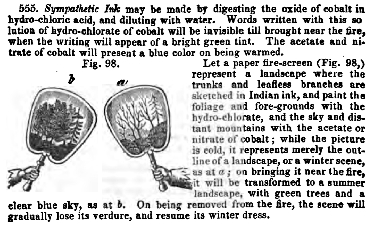By Kristie Macrakis (Atlanta Science Tavern Contributor)
When Marc Merlin, the Atlanta Science Tavern host, asked if I’d be willing to write a blog for Wonders & Marvels, I jumped at the chance. I always thought of my current topic – invisible ink – as a wonder, a marvel of nature. It would fit perfectly. But then he added: “make sure to include a nice image.”
A nice image! My mind started racing. It’s not that the history of invisible ink doesn’t have images; it does (and they are not a pile of blank pages!) You can think of the well-known ones yourself: a lemon juice written piece of paper with the letters scorched brown by a candle or lamp, a yellowed piece of paper from the American Revolutionary War with developed invisible ink, letters that fluoresce under a UV light known to many school children etc. etc. etc.
But the slice of history I wanted to focus on was elusive when it came to finding an image. I have imagined it many times. And this image is a real marvel, an awesome sight.

Do-it-yourself invisible ink paper fire-screen, "Chemistry, Collegiate Institutions, Schools, Families, and Private Students" (1857)
In Eighteenth Century Paris, changeable landscape fire-screens for fireplaces became all the rage. A barren winter landscape with tree trunks and branches was painted on a fire-screen with ordinary India ink. The artist then painted a solution of cobalt chloride on the screen to create lush shrubs and greenery. The cobalt was invisible initially, but as soon as the heat from the fire reached the screen, the barren winter landscape magically turned into a verdant green landscape. When the heat source is removed, the landscape becomes barren winter again. You should try it; it is truly magical and beautiful.
Then there’s the story behind this special effect of the 18th and early 19th Century. In the early 1700’s Jean Hellot, the French industrial chemist and inspector general of dyeing, climbed the hills of Saxony in search of this magical rock. He had gotten the tip from a mysterious German alchemist (a Dorothea Walchin or Wallich). The mountains and hills of Schneeberg were alive with silver and cobalt. But extracting cobalt was not an easy business when spirits seemed to inhabit forests, caves and mountains. The German word “Kobold” means goblin, and a miner’s kobold was a mischievous invisible spirit that haunted subterranean places like mines.
But Hellot persisted and was the first to write a scientific article on this new cobalt invisible ink in 1737 for the proceedings of the Academy of Sciences. The only problem is that Hellot himself is a bit invisible. Since he was a practical chemist he is not as well known as the chemical revolution luminaries like Antoine Lavoisier. And the worst part is that I can’t find a painting of Hellot. I don’t know what this invisible ink pioneer looks like!
So this brings me to my plea. If anyone has information or information leading to an image of the changeable landscape fire screens or an image of the elusive Jean Hellot, please let me know!
Kristie Macrakis is a historian of science and of espionage. Her research interests include the science in Nazi Germany and Post-War Germany, Cold War espionage including the East German Ministry for State Security. (See her Seduced by Secrets, Cambridge, 2008). Kristie is currently writing a book on the history of invisible ink from ancient to modern times.
